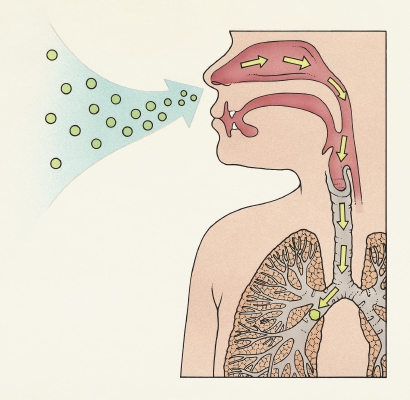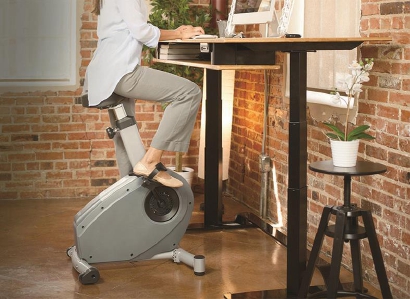



Wear a mask, wash your hands frequently, and use chopsticks and spoons … … The epidemic situation in COVID-19 has made us pay more attention to the health habits in our lives. Many details of life that have been repeatedly mentioned before but are easily overlooked can benefit our physical and mental health a lot if we stick to them seriously.
In fact, there are more details in daily life that deserve our attention. Whether it’s breathing, sitting posture, relaxing, eating and walking, exploring some scientific doorways and making some small changes may make our life more healthy and enjoyable.
Learn to breathe correctly
Improve memory and sleep
Breathing may be the most natural thing in the world, but more than half of people in the world breathe in the wrong way. In fact, whether the breathing method is correct is much more important than we thought — — Correct breathing can improve our memory and improve our sleep quality.
The correct way is to breathe through the nose. The nose that stands out obviously on our face is carefully designed by nature: the nose hair and snot in the nose can catch dust and other foreign objects in the air; The nasal cavity behind the nose is a spongy space almost as big as the oral cavity; The nasal mucosa in the nasal cavity can adjust the temperature and increase the humidity, not only adjust the air that is too cold or too hot inhaled from the outside to the temperature equivalent to the body temperature, but also can trap pathogens with mucus; Sinus is an air-filled space connected with nasal cavity, where air circulates, increasing more nitric oxide, killing bacteria and viruses, dilating respiratory blood vessels and letting more oxygen enter the blood.
People may not understand that breathing through the nose will increase the air resistance by 50% compared with breathing through the mouth, so that the cardiopulmonary function can be exercised more, and the inhaled oxygen can be 20% more than breathing through the mouth.
The benefits seem to be more than that. Breathing through the nose can also promote brain function. It is found that the young rats who breathe through their mouths complete the maze task more slowly than the young rats who breathe through their noses, and there are fewer neurons in the hippocampus (an important part of the brain for learning and memory) in adulthood. The human memory test found that people who breathe through the nose have stronger memory ability and better test scores.
Scientists explain that the nasal cavity can connect with the olfactory bulb of the brain through sensory neurons and establish direct contact with the emotional and memory processing center of the brain. In addition to transmitting odor information, these neurons can also sense the air entering and leaving the nasal cavity, and lock the brain waves synchronized with these airflow, and then transmit these synchronized brain waves from the odor processing brain area to the brain area responsible for memory, emotion and cognition.
However, many people who breathe through their mouths miss out on these benefits. It is estimated that 50% of children and 61% of adults often breathe through their mouths. Frequent breathing through the mouth will bring about bad breath, poor sleep, learning difficulties, bad teeth, and even lead to jaw deformity.
People who occasionally breathe through their mouths should give themselves a wake-up call to remind themselves to pay attention to their breathing methods at all times and how they breathe during the day and night. If you find yourself breathing through your mouth often, you can take some corrective measures, such as buying a roll of tape paper and sticking your mouth when you sleep at night. A small study found that this method can reduce snoring and drowsiness in patients with mild obstructive sleep apnea.
Mastering the breathing frequency can also bring many wonderful uses. For example, if you want to be calm, reduce the number of breaths to six times per minute, which can trigger the body reaction of vasodilation and slow heart rate. At the same time, concentrated thinking and slow and long exhalation can also stimulate the vagus nerve, which is specialized in rest and digestive reaction, and the corresponding fight and flight reaction. If the number of breaths is reduced to three times per minute, then θ Brain waves will increase, and people will feel sleepy at the same time.
But whether the breathing frequency is fast or slow, breathing through the nose is the best choice. When breathing through the nose, you might as well hum a minor tune. Humming through the nose can stir the airflow in the sinuses and promote the production of more nitric oxide, sometimes up to 15 times as much as usual, which is of great benefit to the immune system and cardiovascular and cerebrovascular systems.
Change the traditional sitting posture
Avoid sedentary risks.
When it comes to correct sitting posture, we may all know not to lean back lazily or cross your legs, but many people may not be able to strictly abide by it. However, even if the standard sitting posture is adopted, sedentary is very harmful to health. Studies have shown that sedentary behavior is equivalent to smoking, which will increase the risk of heart disease, diabetes and even cancer. There is no doubt that we should all try to sit less and move more, and perhaps adopt a more suitable sitting posture, which is more conducive to our health.
A classic survey report describes 100 different sitting postures adopted by different cultures all over the world, among which the most common ones are sitting cross-legged, kneeling and squatting. These are also the sitting postures that children like, but more people are often used to understanding "sitting" as "sitting in a chair". This brings a big problem — — Sedentary.
We might as well see how the Hazards sit. Haza people are a modern hunter-gatherer tribe in Tanzania. They sit for about 9 hours every day on average, but instead of sitting in a chair, they take various postures, such as squatting or sitting on the ground in different postures. Activity monitoring shows that these sitting postures require significant muscle activity, thus avoiding the disadvantages of sedentary. The support of the chair, including the high backrest and armrest, will eliminate this muscle activity, but this may be the reason why people like to sit in the chair.
Yue Se Bettaney-Saltikoff of the University of Teesside, UK, thinks that ordinary chairs will put more pressure on the back if the lower part of the back lies flat on the back of the chair.
So, what is the best sitting posture? Bettaney-Saltikoff found that kneeling or using a stool with a saddle can help keep the spine in the best position, and squatting is also possible.
Leon strack, a physiotherapist at Curtin University in Australia, said that people can adopt some active sitting positions to avoid being still for a long time.
Strack also put forward some suggestions to fundamentally change the sedentary situation of copywriters. For example, design a more scientific working environment so that people can improve their work efficiency while doing a little activity — — Maybe we can design a desk that can do cycling or walking under the desk from time to time. At present, if the nature of your job makes you have to sit for a long time, please don’t forget to stand up and stretch your legs often.
Try to meditate
Release pressure with "micro-relaxation"
In fact, it is not easy to work at home. Every day, in addition to finishing the work, children should be allowed to eat and play. It may be after 9 pm when the children go to bed, wash clothes and tidy up everything. Finally, I can sit down with my lover and turn on the TV — — At this moment, I have been looking forward to it for hours.
Relaxation makes us happy and is a natural medicine to eliminate fatigue. More and more evidence shows that persistent high pressure will lead to chronic inflammation, which is very unfavorable to our physical and mental health. However, is watching TV the best way to relax?
On this issue, Claudia Hammond and Gemma Lewis of University College London, UK, surveyed 18,000 people from 134 countries and found that watching TV is one of the top ten relaxation activities that people usually do. At the same time, 68% people want to have more rest, because rest is also an unconscious relaxation.
Can running be regarded as a way to relax? Patricia Gebhardt, a doctor at New York Medical College, believes that both sympathetic and parasympathetic nervous systems are related to unconscious behavior. The sympathetic nervous system will enhance the fight-or-flight response and produce harmful particles called free radicals. When relaxed, the parasympathetic nervous system will start, giving the body a chance to recover from fatigue.
"People don’t feel dangerous when jogging," Gebhardt said, which means that the sympathetic nervous system will not respond. "Especially when people often jog in the natural environment, it will make people feel more peaceful." In addition, exercise also produces a pleasant chemical endorphin.
However, sometimes people need to decompress, but they don’t have time to jog or watch TV. At this time, they need a kind of "micro-relaxation". Meditation may be a micro-relaxation habit worth cultivating. There is evidence that meditation can reduce the activity of amygdala, which is the part of the brain involved in the fight or flight response. When entering meditation, the brain will stop most of its activities and concentrate on meditation and the surrounding environment.
A research test at La Salle University in Philadelphia, USA, shows that meditation can really make people enter an "absent-minded" state of relaxation. There is a skill to cultivate this state consciously and relax yourself at any time of the day. For example, try to wait for the bus absently, focus on the details of the surrounding environment you see, hear, smell and perceive, and let yourself enter a calm and wave-free state of relaxation.
Eat regularly and eat slowly.
Concentrate on eating and don’t eat too much.
Eating can be said to be the top priority in life. From the time and speed of eating to the choice of dining companions, the way of eating will have a great impact on our waistline and happiness.
First of all, talk about meal time. Many of us are accustomed to regard dinner as the most important meal of the day, but in fact, our bodies are more sensitive to insulin in the morning, and the peak blood sugar drops faster after breakfast than after dinner. Leonie Ruddick Collins of the University of Aberdeen in the United Kingdom pointed out that in the morning, the stomach is emptied, the intestinal peristalsis is faster, and the acid content of enzymes, peptides and bile is higher. Therefore, a reasonable breakfast can reduce the risk of diabetes, which is also good for intestinal health and digestive system.
Regular meals are also beneficial, which helps to regulate the genes that control the biological clock. Changing the meal time often will interrupt this coordination. In addition, people with weight loss goals can limit the interval between meals to a short time, such as delaying breakfast for 90 minutes and advancing dinner for 90 minutes. By doing this, you can lose twice as much fat in ten weeks as those who keep a normal diet.
The speed of eating is also important. Chewing 100 times per bite may be too much, but people who eat slowly do eat less, which may be because the hormones released after eating take about 20 minutes to work, and eating slowly is more likely to produce satiety. At the same time, eating foods with high fiber content will also require more chewing, which will slow people down.
Fast eaters tend to have higher levels of triglycerides in their blood. Triglyceride is a key indicator of metabolic syndrome. Although the reason is not clear, the researchers suggest that we should focus on food and sit down safely when eating to avoid interference from TV, computer and mobile phone.
One more question, is it better to eat alone or together? Even if there is no need for epidemic prevention and control, busy life and families living alone make eating alone more common than in the past. Research suggests that this may be a good thing. Helen Ruddock of the University of Liverpool, UK, found that although eating with friends often leads to happiness and higher life satisfaction than eating alone, people eat more when they eat with friends. Perhaps, it is a way to kill two birds with one stone by eating leisurely with friends who have good eating habits and like to eat slowly.
Optimistic gait walking
Keep walking every day.
Walking on two feet is actually a very dangerous way, so few species except humans will adopt this way of walking. Although incredible, we still use these two small platforms to keep balance and move, but we rarely think about how to walk is really beneficial to health.
Although the way we walk is basically the same, everyone’s gait is different, and the difference is even enough to be used as a biometric password. However, some weird gait may be a problem.
For example, a slight change in leg swing may cause damage to knee cartilage caused by the force of heel hitting the floor. In the past 50 years, the incidence of knee osteoarthritis has doubled, and it is not enough to explain it only by the increase of human life expectancy or obesity rate. Walking barefoot or wearing flat and light shoes can reduce the pressure on the knees, but high heels, on the contrary, will bring more pressure on the knees, so changing a pair of shoes that fit the feet may be good for the knees.
The way you walk will also have many effects. Experiments show that people who walk with "optimistic" gait can remember more positive words in the list, while people who walk with "sad" gait will remember more negative words. For the "low-headed people" who like to watch their mobile phones while walking, this will not only lead to slower walking, but also may lead to neck strain and injury.
Daniel Lieberman, an evolutionary anthropologist at Harvard University in the United States, made a health survey of modern hunter-gatherers and postal workers. It shows that our goal should include walking for two hours every day, but most people can’t achieve this goal. Therefore, don’t worry about whether your gait is different from others, just keep walking every day. (Fang Lingsheng/Compiled)
关于作者